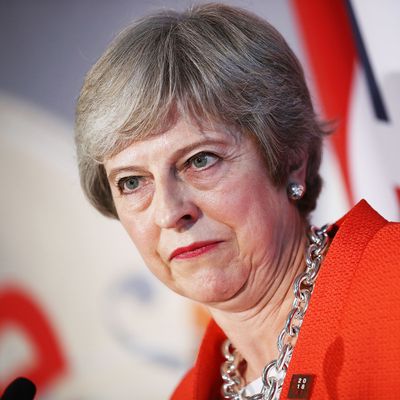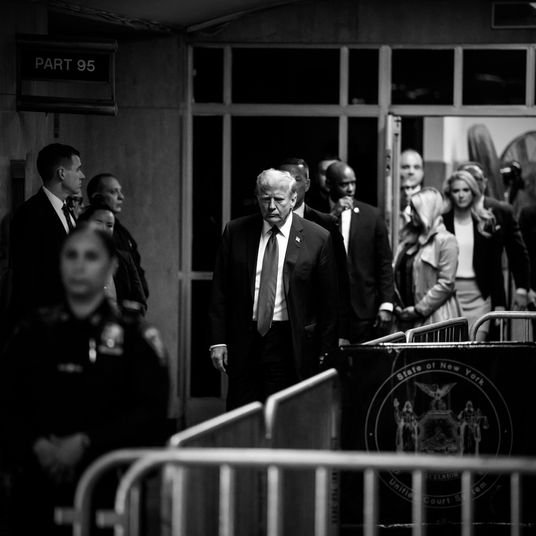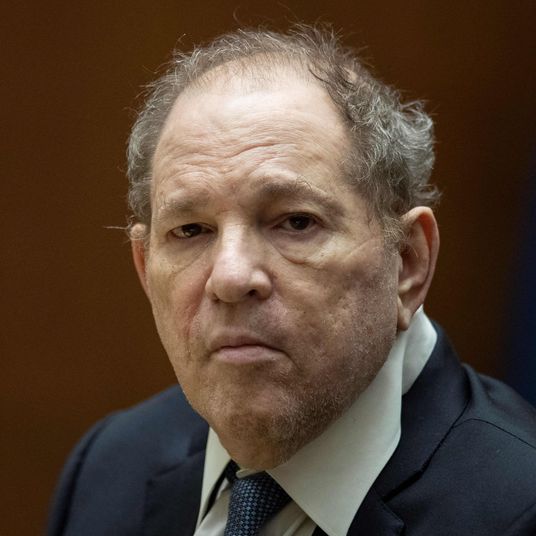
Earlier this week, the United Kingdom and European Union (finally) reached a preliminary agreement on the terms of their divorce — and, in so doing, plunged Theresa May’s government into a trial separation.
On Wednesday afternoon, the British prime minister announced that, after hours of vigorous debate, she had persuaded her cabinet to support her Brexit deal. Shortly thereafter, the E.U.’s chief negotiator, Michel Barnier, praised the draft agreement as a “decisive step,” telling reporters, “if nothing extraordinary happens,” the deal would be finalized by month’s end.
Hours later, something extraordinary happened (by Barnier’s ostensible definition, anyway): May’s Brexit secretary Dominic Raab — the member of her cabinet most directly responsible for the terms of the deal — resigned in protest. Three other cabinet members followed him to the exits.
May’s deal received a similarly chilly reception in Parliament. Tory backbenchers, May’s coalition partners in Northern Ireland’s Democratic Unionist Party, and the Labor opposition had all blasted the deal from the moment it was announced. And actually reading (or skimming) its 585 pages of text did not soften their objections, while the cabinet resignations ostensibly fortified them.
May told the House of Commons that “the choice is clear: We can choose to leave with no deal, we can risk no Brexit at all” — at which point, the remainers in the chamber expressed their enthusiasm for the latter proposition — “or,” May continued, after the cheering subsided, “we can choose to unite and support the best deal that can be negotiated.”
If the U.K. does not reach an agreement over customs and border rules by March 29 — when Britain will cease to be an E.U. member — it will (almost certainly) see its currency plunge in value, its ports descend into chaos, and its economy slow to crawl. May’s best hope is that the specter of a “no deal” nightmare will ultimately force her dissenters to fall in line, for the good of the country (and perhaps their own sterling-denominated investments).
The core obstacle to such a development is simple: There is no viable version of Brexit that will not leave Britain worse off than it is under the status quo — and thus, it is in virtually no one’s political interest to endorse any actually existing Brexit agreement. Tory’s far-right Brexiteers would much rather deride any deal that doesn’t allow the U.K. to retain all the benefits of E.U. membership (and that fails to restore Britain’s dominion over the Suez Canal) as a betrayal of the one true Brexit — while Labor has no interest in simultaneously antagonizing its remain contingent, disappointing its pro-Brexit faction (by exposing it to the grim reality of its position), and strengthening Theresa May’s grip on power.
In more granular terms, the most intractable problem in negotiations between the U.K. and E.U. has been the status of the border between Ireland and Northern Ireland. Free movement and trade between the two nations was a cornerstone of the Good Friday Agreement, and thus, a pillar of peace in the region ever since. Thousands of people cross the border daily for work, and many companies have built business models and supply chains that depend on the maintenance of seamless commerce between Ireland and Northern Ireland. Thus, many in May’s Tory Party insist that any Brexit deal must keep that border open.
But Ireland is not leaving the E.U. And the E.U. is, among other things, a single market and a customs union. As a single market, E.U. members synchronize their consumer, labor (including immigration), and other commercial regulations; as a customs union, they apply synchronized tariffs on goods produced outside of the union. Thus, if Britain exits both the single market and customs union, then Ireland would be forced to impose tariffs on products produced in Northern Ireland, and check them at the border for compliance with the E.U.’s regulations.
Now, the U.K. could leave the E.U. while remaining in the customs union, and/or single market. But staying in the former would bar the U.K. from brokering its own bilateral trade agreements, while staying in the latter would oblige it to subordinate many of its regulatory and immigration policies to E.U. directives.
Thus, many Brexiteers in May’s party insist that any Brexit deal must include the U.K.’s withdrawal from both.
Her government’s draft agreement with the E.U. does not satisfy that demand. Instead, according to NBC News, the deal would keep the whole of the U.K. in the customs union — but not the single market — while leaving Northern Ireland subject to the rules of both. May hopes that she can get her parliamentary allies to swallow this bitter pill by providing them with a quarter-teaspoon of sugar: The deal describes these arrangements as a mere temporary “backstop,” until a more mutually satisfying solution can be worked out.
But the deal does not put an expiration date on said backstop. And it’s unclear how the U.K.’s simultaneous demands for an open border with Ireland — and total sovereignty over its trade and regulatory policies — could ever be reconciled.
Thus, May’s partners in Northern Ireland’s DUP find the deal repulsive. After all, they are a unionist party — and the deal would effectively create a regulatory border between Northern Ireland and the rest of the U.K. And, of course, hard-line Brexiteers can’t very well accept their great nation’s indefinite subjugation to the tyranny of tariff schedules dictated by Brussels.
May’s Tory dissenters are now pushing to evict her from leadership through a vote of no confidence. For the moment, though, they don’t appear to have the votes. Which makes sense: While it is hard to see why any of May’s rivals would want to support her Brexit deal, it’s even harder to see why they would want to be in her shoes (before March 29, anyway).






























